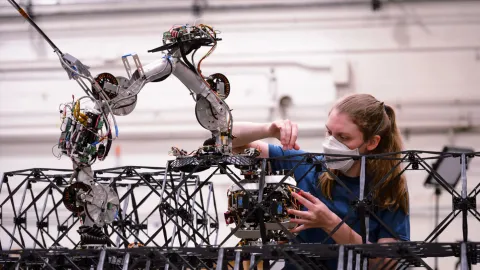NASA tests autonomous space robots for off-world construction

- With the Artemis mission, NASA's aims to lay the foundation for establishing a long-term presence on the Moon.
- To lower the costs associated with building infrastructure off-world, NASA is testing robots that can plan and build autonomously.
- In a recent test, researchers gave the robots the plans for a moon shelter, and the robots figured out how to build it.
NASA is testing out autonomous space robots to build shelters and solar arrays on the moon and Mars.
The challenge: With Artemis, NASA isn’t just trying to return astronauts to the moon — it hopes to lay the foundation for establishing a long-term presence on the lunar surface so that it can develop the tech needed to get people to Mars and beyond.
If we want astronauts to spend extended periods of time on the moon and Mars, we’re going to need a way to build and maintain infrastructure off-world — they’re going to need habitats, power stations, communications towers, and more.
The size of the structures is only limited by the number of building blocks that can be supplied.
Kenny Cheung
Space robots: Manufacturing all of this on Earth and sending it to space would be hugely expensive, so NASA is taking a different approach, designing a robotic system to autonomously construct off-world structures from basic building blocks made from local resources.
They call the technology ARMADAS (“Automated Reconfigurable Mission Adaptive Digital Assembly Systems”), and in January, they published a paper in Science Robotics detailing a demonstration of the robots.
How it works: The ARMADAS demo involved three space robots: two builder bots (called SOLL-Es, “Scaling Omnidirectional Lattice Locomoting Explorer”) and one fastening robot (called MMIC-I, “Mobile Metamaterial Internal Co-Integrator”).

SOLL-Es are shaped like arched tubes, and they move like inch-worms — the front end of the tube takes a step forward, and then the back end follows suit. These bots are designed to carry and place wire-frame building blocks NASA calls “voxels.”
“The voxels can be made from many different materials and manufacturing processes,” Christine Gregg, ARMADAS chief engineer, told TechCrunch. “Eventually, for space applications, we would like to make voxels from materials we find in situ on the moon or other planetary bodies.”
The MMIC-I robot also moves like an inchworm, but it’s shorter than the SOLL-E bots and small enough to move around inside the voxels. After a SOLL-E places a voxel, its job is to fasten the block to the rest of the structure.
The system builds and error-corrects on its own with no machine vision.
Christine Gregg
During the demo, the three space robots built a shelter about the size of a shed in 100 hours using 256 voxels. While NASA gave the bots the plans for the shelter, it didn’t tell them how to build it — the robots relied on software algorithms to figure out the best approach.
“Because the robots align each small step to the structure in what is essentially a 3D grid, simple algorithms with low computation and sensing requirements can achieve high-level autonomy goals,” said Gregg. “The system builds and error-corrects on its own with no machine vision or external means of measurement.”
Looking ahead: NASA plans to continue developing its ARMADAS, focusing on training the space robots to work with different types of building blocks, including shielding and solar panels.
“Making large structures from small building blocks allows us to use good materials at the lowest cost,” said Kenny Cheung, ARMADAS principal investigator. “The size of the structures that can be made is only limited by the number of building blocks that can be supplied.”
This article was originally published by our sister site, Freethink.





